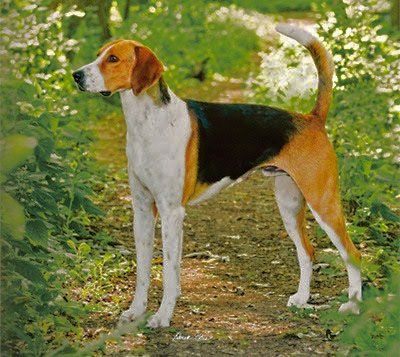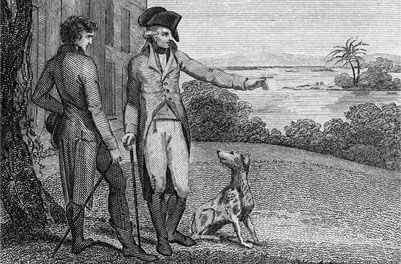 |
I was watching the Kennel Club of Philadelphia's National Dog Show this past Thanksgiving, and Jewel, an American Foxhound won the "Hound" category. She is a slim, athletic-looking dog, with beautiful coloring of black, beige and a russet/orange.
Jewel is from Washington DC. And this is appropriate because she is from the city named after the American president who introduced the American Foxhound.
Below is more about President Washington's role in the breed from the American Kennel Club:
George Washington, the father of our nation, is also the father of American Foxhounds. In 1770, Washington imported a number of hounds from England and in 1785, he received a number of French foxhounds from the Marquis de Lafayette. These hounds, carefully bred and maintained by Washington, are the founders of today’s American Foxhound. More than 30 hounds were listed in Washington’s journals, including "Drunkard," "Tipler," and "Tipsy."And here is more on the character of the American Foxhound:
The Foxhound is well-mannered in the home. He gets along best with human or canine companionship. He is a tolerant, amiable and gentle dog, even though he is not very demonstrative. Many are reserved with strangers. He is first and foremost a hunter, ever ready to hit the trail. He needs daily exercise in a safe area. Once on a scent, he will follow gleefully, heedless of commands. This is a dog that likes the outdoors. He bays.
 |
The above illustration is from the website for George Washington's Mount Vernon Estate, Museum and Gardens, and it is titled: Brissot Interview with Gen. Washington, engraved by Owen after Kirk, 1797.
The book from which the illustration came:
Historical Account of the Most Celebrated Voyages, Travels, and Discoveries, from the Time of Columbus to the Present Period
 |
The illustration title reads:
Published Dec, 1 1797, Newbery, corner of St. Pauls.Below is an enlargement of the text that appears below the illustration:
 |
The text for the illustration reads:
I hastened to arrive at Mount Vernon, the seat of General Washington, ten miles below Alexandria, on the same river. On this route you traverse a considerable wood, and after having passed over two hills, you discover a country house, of an elegant and majestic simplicity. It is preceded by grass plats; on one side of the avenue are the stables, on the other a green-house, and houses for a number of negro mechanics. In a spacious back yard are turkeys, geese, and other poultry. This house overlooks the Potowmack, enjoys an extensive prospect, has a large and elevated portico on the front next the river, and a convenient distribution of the apartments within. The general came home in the evening, fatigued with having been to lay out a new road in some part of his plantations. He has often been compared to Cincinnatus : the comparison is doubtless just. This celebrated general is nothing more at present than a good farmer, constantly occupied in the care of his farm and the improvement of cultivation.Unfortunately, there is nothing on the dog (at least in these pages), but Wikipedia lists Washington's pet dogs, and names three of his dogs as American Staghounds. This looks like a likely breed for the dog in the illustration. Could the dog be Sweet Lips, Scentwell or Vulcan? I think not Vulcan, and the dog's docile and loving nature suggests Sweet Lips might be a good name :_).
(Here is more on Washington's creative name-assignments for his dogs:
In addition to Sweet Lips, Tipsy, Tipler, Cloe, Searcher, and Drunkard, the hounds portrayed in Steven Kellogg’s delightful illustration in Our White House: Looking In, Looking Out, Washington had more than twenty additional canine companions. They included: Mopsey, Pilot, Tartar, Jupiter, Trueman, Truelove, Juno, Duchess, Ragman, Countess, Lady, Rover, Vulcan, Singer, Must, Tiyal, Forrester, Captain, and the frisky Madam Moose, of whom Washington noted in his diary, “A new coach dog [arrived] for the benefit of Madame Moose; her amorous fits should therefore be attended to.” From Presidential Menageries: George Washington, Hound Dogs, and Super Mules By: Mary Brigid Barrett.)
 |
From Our White House: Looking In, Looking Out
Here is what I could find about Brissot, Owen and Kirk (the names on the title for the first illustration above):
Jacques Pierre Brissot:
Jacques Pierre Brissot (15 January 1754 – 31 October 1793), who assumed the name of de Warville, was a leading member of the Girondist movement during the French Revolution...
Brissot became known as a writer, and was engaged on the Mercure de France, on the Courrier de l'Europe, and on other papers...
As an agent of this society he paid a visit to the United States in 1788, and subsequently published in 1791 his Nouveau Voyage dans les États-Unis de l'Amérique septentrionale (3 vols.).
[Source: Wikipedia]
Kirk:
From Wikipedia:
Not to be confused with sculptor Henry Kirke Bush-Brown (1857-1935), the nephew of Henry Kirke Brown.Also from Henry Kirke Brown papers, 1836-1893
Henry Kirke Brown (February 24, 1814, Leyden, Massachusetts – July 10, 1886, Newburgh, New York) was an American sculptor.
He began to paint portraits while still a boy, studied painting in Boston under Chester Harding, learned a little about modelling, and in 1836-1839 spent his summers working as a railroad engineer to earn enough to enable him to study further...
His equestrian statues are excellent, notably that of George Washington (1856) in Union Square, New York City.
(in the Archives of American Art):
[Kirk] discusses his work, including progress on his statue of George Washington, located in Union Square, New York City. Letters to his family from Rome and Florence allude to his awe of Italy's monuments. Also included are letters from Washington, D.C. during Brown's tenure as a member of the U.S. Art Commission in the 1860s.
Biographical/Historical Note: Sculptor and portrait painter; born in Leyden, Mass.; died in Newburgh, N.Y.
Owen:
Hanks, O.G. Landscape painter and copperplate engraver worked in 1843 in Cincinnati, Ohio (Hamilton)...This may well been the Owen G. Hanks who apprenticed with the engravers Rawden, Hatch and Rice in New York City in 1838; born in Troy New York, before 1838, he was active in New York City from 1848 to 1851 and form 1856 to 1861. [Source: Google books]
Unfortunately, I couldn't find any specific American Foxhound amongst Washington's dogs.
Here is the video for the Philadelpahia Dog Show, with Jewel.